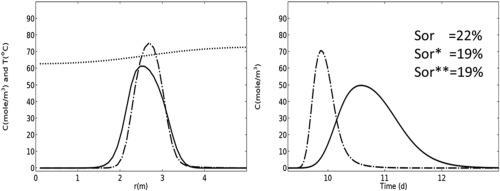Journal of Petroleum Science and Engineering ( IF 5.168 ) Pub Date : 2020-07-22 , DOI: 10.1016/j.petrol.2020.107652 Tom Pedersen

|
Residual oil saturation (Sor) is the fraction of immobile oil that remains after a water flood. This information is important for calculating recoverable reserves and evaluating EOR campaigns. Single Well Chemical Tracer (SWCT) tests yield a near-well average Sor based on a large rock volume. Correctly performed and analyzed, SWCT tests yield reliable Sor estimates. There are, however, two important effects that commonly are ignored. One is cooling of the reservoir during injection of the cold brine resulting in decreased hydrolysis rate of the primary tracer. The other is the hydrolysis rate's pH dependence. To study these phenomena, we have developed a numerical model of an ethyl acetate SWCT test and applied it to a generic case with test and formation data based on published values. An analytical model is used to calculate how the brine injection temperature varies with time. The ethyl acetate hydrolyses into ethanol and acetic acid that lowers the pH and changes the hydrolysis rate. Any buffer capacity in the injected fluid or formation is neglected. Our model is the first ever to combine realistic temperature calculations with pH dependent ethyl acetate hydrolysis rate during a SWCT test. Sor is estimated from synthetic tracer production curves using the direct chromatographic separation equation as well as the mean residence time. A large number of simulations were performed to investigate how the Sor estimates vary with different model assumptions and input data. In all cases, both methods underestimate the true Sor, typically by 2–4% - in some cases significantly more. We demonstrate that neglecting dispersion in the wellbore during injection and production is warranted with the rock and test data used in this study.
中文翻译:

温度梯度和pH对S的影响或SWCT测试的估计-无缓冲情况
剩余油饱和度(S或)是注水后剩余的不挥发油的比例。此信息对于计算可采储量和评估EOR活动很重要。单井化学示踪剂(SWCT)测试得出的平均井S为近井平均,或基于大量岩石。正确执行和分析的SWCT测试可得出可靠的S或估计。但是,有两个通常被忽略的重要影响。一种是在注入冷盐水期间冷却储层,导致主示踪剂的水解速率降低。另一个是水解速率的pH依赖性。为了研究这些现象,我们开发了乙酸乙酯SWCT测试的数值模型,并将其应用于基于已发布值的测试和地层数据的一般案例。使用分析模型来计算盐水注入温度如何随时间变化。乙酸乙酯水解成乙醇和乙酸,降低了pH值并改变了水解速率。忽略注入流体或地层中的任何缓冲能力。我们的模型是有史以来第一个在SWCT测试中将实际温度计算与pH依赖的乙酸乙酯水解速率相结合的模型。或使用直接色谱分离方程以及平均停留时间从合成示踪剂生产曲线估算得出。进行了大量模拟以调查S或估计值如何随不同的模型假设和输入数据而变化。在所有情况下,两种方法都低估了真实的S或,通常低2-4%-在某些情况下要高得多。我们证明,在这项研究中使用的岩石和测试数据可以保证在注入和生产过程中忽略井眼中的分散。


























 京公网安备 11010802027423号
京公网安备 11010802027423号